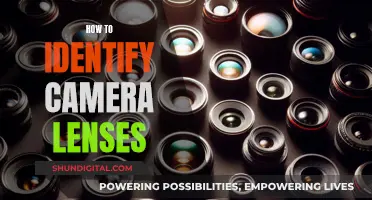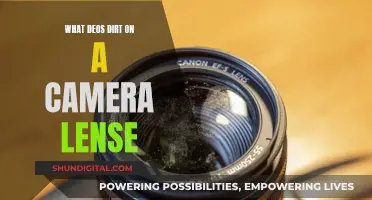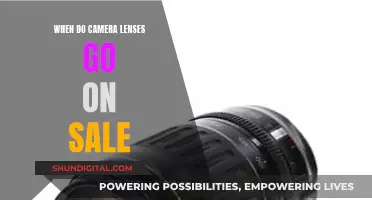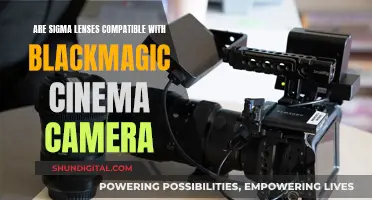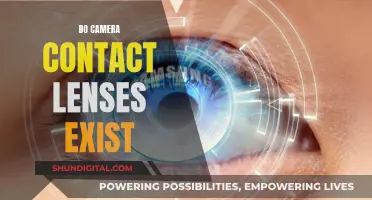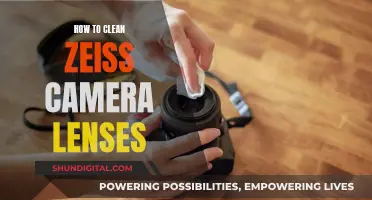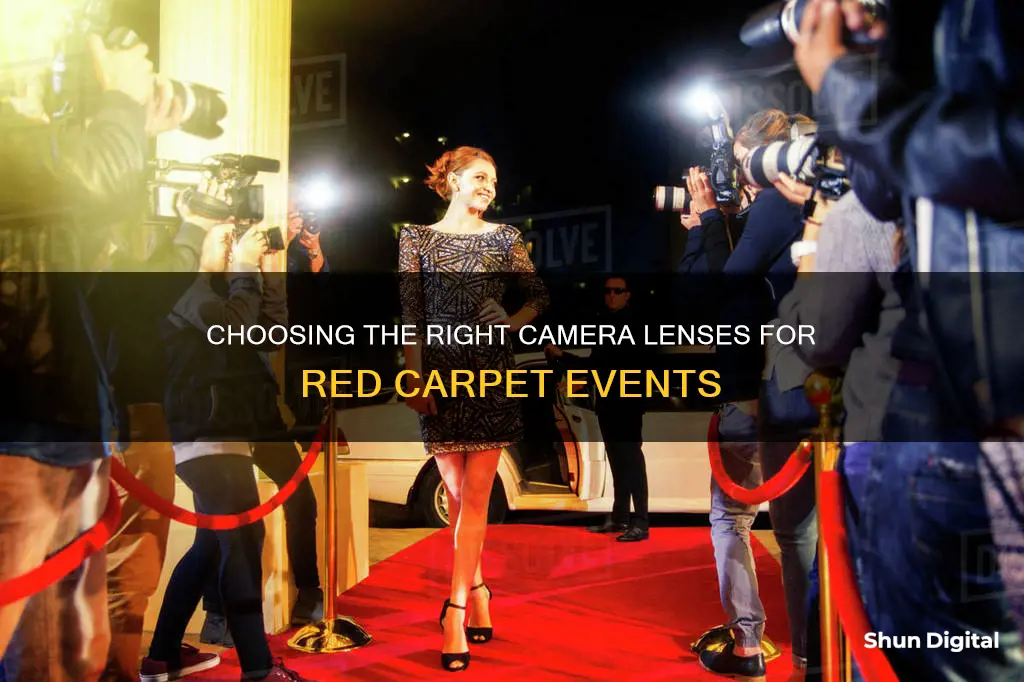
Capturing the perfect shot on a red carpet is a challenging task. Red carpets are often chaotic, with photographers vying for the attention of celebrities and having to deal with the constant movement of people. To get the best shots, photographers need to have the right equipment, including a good camera lens.
The ideal lens for red carpet events depends on various factors, such as the distance from the subject, lighting conditions, and the desired composition of the photographs. A standard zoom lens like a 24-70mm is usually a safe choice for full-length shots, but for bigger events, a 70-200mm lens might be needed to capture head-to-toe images. Prime lenses like a 50mm f/1.2 or an 85mm f/1.2 can also be useful for full-length and headshots, respectively.
Additionally, photographers should consider using a flash to ensure proper lighting, especially if the event is indoors or in low-light conditions. An on-camera flash, such as a Canon EL-1 or Godox V1, can help fill in unsightly shadows and create more dynamic lighting.
Ultimately, the key to successful red carpet photography is being prepared, knowing your equipment, and adapting to the unique challenges of each event.
| Characteristics | Values |
|---|---|
| Lens type | Zoom lenses, such as 24-70mm, 70-200mm, 16-85mm, 17-55mm, 18-200mm, 17-40mm, 24-105mm, 50mm, 85mm, 135mm, 24-70mm, 70-300mm, 70-200mm, 300mm, 18-55mm, 55-300mm, 90mm |
| Flash | On-camera flash, such as SB-700 speedlight, 420EX speedlite, or an on-camera flashgun. |
| Lighting | Natural light or direct flash. |
| Camera | Nikon D300, D90, 5D, 1Ds, 7D, Canon |
What You'll Learn

Camera lenses for full-length red carpet photos
Capturing the perfect shot on a red carpet is a daunting challenge, especially for beginners. Here are some tips for choosing the right camera lenses for full-length red carpet photos:
The lens you choose depends on the composition you want and the space you have to shoot. If you're shooting full-body portraits, a 18-55mm lens is a good option. This focal length range will allow you to get close enough to your subject and provide enough flexibility due to the zoom.
If you're shooting with a crop sensor camera, keep in mind that the effective focal length will be longer than on a full-frame camera. For example, a 50mm lens on a crop sensor camera with a 1.5x crop factor will give you an effective focal length of 75mm, which may be too tight for full-length shots.
For red carpet events, it's also important to consider the lighting conditions. Most red carpet events have adequate lighting, but if you're concerned about low-light situations, a lens with a wider aperture (such as f/1.8 or f/2.8) will help you capture sharper images in low light.
Additionally, having a flash can be useful, especially if you need to fill in shadows or add a bit of light to your subject. Using a flash bracket can help reduce unsightly shadows by keeping the flash centred directly above your lens.
Other Considerations
When shooting full-length red carpet photos, it's important to get close enough to your subject to capture their entire outfit, including their feet, head, and arms. This may require you to use a wider lens or zoom out to ensure you don't crop out any important details.
It's also crucial to pay attention to your white balance settings, especially if the red carpet is lit by tungsten or orange-coloured lights. Start by setting your white balance to 5500 Kelvin (daylight) and adjust from there until you find a setting that looks natural.
Lastly, don't be afraid to ask your subjects for their attention and to strike a pose. Eye contact is a powerful tool in creating a connection between the viewer and the subject, so strive to capture it in your photos.
With these tips in mind, you'll be well on your way to capturing stunning full-length red carpet photos that impress your clients and viewers.
Squaretrade Coverage for Camera Lenses: What You Need to Know
You may want to see also

Camera lenses for close-up red carpet photos
Capturing the perfect shot on a red carpet can be a daunting task, especially if you are new to event photography. The right camera lens can make all the difference in getting that perfect shot. Here are some tips on choosing the right lens for close-up red carpet photos.
Choosing the Right Lens
The lens you choose will depend on the composition you want and the space you have to shoot. If you want to keep things simple, a standard zoom lens (24-70mm or something similar) will allow you to capture full-length and closer shots. If you are positioned further back from the red carpet, you may need a lens with more reach, such as a 70-200mm.
If you want to capture portraits, a focal length of around 90mm is ideal, but keep in mind the crop factor of your camera. For full-body portraits, a wider lens such as an 18-55mm or 30-40mm will be more suitable.
Lighting and Flash
In addition to choosing the right lens, lighting and flash are also important considerations. You may want to use an on-camera flash, such as a Canon EL-1, Profoto A1, or Godox V1, to ensure your photos are well-lit. Using a flash bracket can help reduce distracting shadows by keeping the flash centred above your lens.
Balancing your flash with ambient light can create more dynamic lighting. If the event organisers have their lighting set up, use your flash as a fill light to reduce unsightly shadows. You can also use tools like a bounce card or diffusion tool to soften the light from your flash and create a more flattering effect.
White Balance
Another important consideration is white balance, especially if the red carpet or media event is lit by tungsten or orange-toned lights. Setting your camera's white balance to 5500 Kelvin (daylight) is a good starting point, and you can adjust from there until you find a natural-looking setting.
Final Thoughts
When photographing a red carpet event, it's important to be prepared, flexible, and able to adapt to the lighting and space constraints. With the right lens and lighting setup, you'll be well on your way to capturing stunning close-up photos that impress your clients and viewers.
Pentax Lenses: Compatibility with Pentax Cameras
You may want to see also

Camera lenses for red carpet photos with a single body
Capturing the perfect shot at a red-carpet event can be a daunting task, especially if you are a novice or an amateur photographer. Here are some tips to help you prepare for such an event and capture stunning images that will impress your clients and viewers.
Choosing the Right Lens:
- Standard Zoom Lens: If you want to keep things simple, a standard zoom lens (24-70mm or similar) will do the trick. This will allow you to capture full-length and closer-up shots of your subjects. However, if the photographer area is set further back from the red carpet, you may need a lens with a longer focal length, such as a 70-200mm, to achieve the same results.
- Fixed Focal Length Lenses: If you are unsure about the distance to your subjects or they are moving quickly, fixed focal length lenses can be a good choice. For example, an 85mm or 90mm lens can be great for portraits, but keep in mind the crop factor of your camera, which may affect the effective focal length.
- Other Options: Depending on the event and your personal preferences, you may also want to consider other lenses such as a 17-55mm, 18-55mm, 16-85mm, or 70-300mm.
Lighting and Flash:
- Direct Flash: Using an on-camera flash (e.g., Canon EL-1, Profoto A1, or Godox V1) is a safe option. Use your camera's hotshoe for landscape shots or a flash bracket for vertical shots to minimise distracting shadows.
- Balancing Flash and Ambient Light: To create more dynamic lighting, try balancing your flash with the existing ambient light. If the event has lighting set up on the red carpet or media wall, use your flash as a fill light to reduce unsightly shadows.
- Softening the Flash: To achieve a softer and more flattering light, consider using tools like a bounce card or diffusion tools such as a MagMod Magsphere to spread the light more evenly.
- External Light Source: If space permits, you can also set up your own external light source using a flashgun or monolight with an umbrella or softbox to create flattering lighting.
White Balance:
Red carpets and media events are often lit by tungsten lights or other light sources with a warmer colour temperature. Here are some tips to get the right white balance:
- Start by setting your camera's white balance to 5500 Kelvin (daylight) and adjust from there.
- Lower the temperature if your images look too yellow, or increase it if they appear too blue.
- Use temperature-adjusting gels to match the colour temperature of your flash to the ambient light, especially if the ambient light is very warm/orange.
Capturing the Moment:
- Get Their Attention: Politely ask your subjects for a photo and try to get their eye contact. This creates a sense of connection between the image viewer and the subject.
- Full-Length and Close-Up Shots: As a priority, get a full-length shot of your subject, ensuring you don't crop out any body parts. Then move on to closer shots, focusing on their faces or specific features of their outfit.
- Take Turns: If there are multiple photographers, try to take turns capturing photos of each guest to ensure everyone gets a chance.
- Remain Calm: Red carpet events can get hectic, but it's important to remain calm and avoid becoming a "loose cannon." Screaming or behaving aggressively will only hurt your reputation and make it harder to get invited to future events.
Understanding APS-C Camera and Lens Cropping: What's the Difference?
You may want to see also

Camera lenses for red carpet photos with multiple bodies
When preparing for a red carpet event, it's important to consider the type of shots you want to capture, the lighting conditions, and the amount of space you'll have to work with. Here are some tips and recommendations for camera lenses when shooting red carpet photos with multiple bodies:
Lens Selection
If you're working with multiple camera bodies, it's a good idea to have a range of lenses to capture different types of shots. Here are some specific lenses that can be useful for red carpet photography:
- Wide-angle lenses: These lenses are great for capturing the atmosphere and ambience of the red carpet event. Lenses such as the Tokina 11-16mm f/2.8 or a 16-35mm can be excellent for wide-angle shots.
- Standard zoom lenses: Lenses in the 24-70mm range are often referred to as "money zooms" and are versatile options for red carpet photography. They allow you to capture a variety of shots, from portraits to group photos, without having to switch lenses frequently.
- Telephoto lenses: A telephoto lens, such as a 70-200mm or 85mm lens, can be useful for capturing headshots or tighter portraits when you can't get too close to the subject.
- Prime lenses: Prime lenses, such as a 50mm or 85mm, offer excellent image quality and low-light performance. They are great for portraits and can create a beautiful background blur (bokeh).
Lighting and Flash
Red carpet events can vary in lighting conditions, and it's important to be prepared for different scenarios. Here are some considerations:
- Natural light: If you prefer to work with natural light, pay attention to the time of day and the available light sources. You may need to adjust your ISO and shutter speed accordingly to avoid underexposed images.
- Flash: Using a flash can help illuminate your subjects and freeze the action in low-light conditions. Consider using a flashgun or a speedlight, such as the SB-700 or SB800, to brighten your shots and reduce noise.
- Diffusers and bounce flash: To soften the light from your flash and avoid harsh shadows, consider using a diffuser or bouncing the flash off a ceiling or wall. This can create a more flattering light for portraits.
Other Considerations
- Camera settings: Shoot in manual mode (M) and experiment with different shutter speeds, apertures, and ISO settings to find the best combination for the lighting conditions. A fast shutter speed, such as 1/125 or 1/160, can help freeze movement and capture sharp images.
- Composition and framing: Think about the composition you want to achieve. For full-body portraits, a wider lens (e.g., 18-55mm or 30-40mm) is ideal, while a focal length of 55-65mm is often sufficient for headshots and tighter portraits.
- Crop factor: If you're using a crop sensor camera, remember to account for the crop factor when choosing your lenses. For example, a 50mm lens on a crop sensor camera may behave more like an 80mm lens due to the crop factor.
- Stability and support: Consider using a tripod or monopod to stabilize your camera, especially if you're using slower shutter speeds or shooting in low-light conditions.
- Battery life and grip: Ensure you have fully charged batteries and consider using battery grips to extend the battery life of your camera bodies.
Understanding Macro Camera Lenses for Extreme Close-ups
You may want to see also

Camera lenses for red carpet photos with a flash
Capturing the glamour and excitement of a red carpet event requires the right camera lenses, especially when using a flash. Here are some tips and recommendations for lenses to use when photographing red carpet events with a flash:
Lens Focal Lengths
The ideal focal length for red carpet event photography depends on various factors, including the space you have to work in and the type of shots you want to capture. Here are some common focal lengths used for red carpet photos and what they are typically used for:
- 16mm to 35mm: These wide-angle lenses are great for capturing ambient shots of the red carpet event, including the venue, decorations, and large groups of people.
- 50mm to 85mm: This range is ideal for portraits and headshots, allowing you to capture crisp and detailed photos of individuals or small groups without distortion.
- 70mm to 200mm: Longer focal lengths like these are perfect for capturing full-body portraits or photos of people from a distance, especially if you can't get too close to your subjects.
Zoom Lenses vs. Prime Lenses
When it comes to red carpet event photography, zoom lenses offer more versatility, allowing you to quickly adjust your focal length without having to change lenses. However, prime lenses (fixed focal length lenses) often provide better image quality and perform better in low-light conditions, which can be important when using a flash.
Aperture
When using a flash, your aperture setting will affect the depth of field (DOF) and how much of the scene is in focus. A wider aperture (lower f-stop number) will give you a shallower DOF, which is great for isolating your subject and creating a blurry background. A narrower aperture (higher f-stop number) will result in a deeper DOF, keeping more of the scene in focus. For red carpet event photography, an aperture range of f/2.8 to f/8 is generally recommended.
Camera Flash Techniques
Using a flash on the red carpet can help illuminate your subjects and freeze the action, especially in low-light conditions. Here are some tips for using flash on the red carpet:
- Use an external flash unit: An external flash mounted on your camera's hot shoe will provide more power and flexibility than a built-in flash.
- Diffuse the flash: To soften the light from your flash and avoid harsh shadows, consider using a diffuser or bouncing the flash off a ceiling or wall.
- Sync your flash: To capture both the ambient light and the effects of your flash, try using a slower shutter speed and syncing your flash to capture the action.
- Avoid red-eye: When using flash, watch out for red-eye in your photos, which can be caused by light reflecting off the retinas of your subjects' eyes. Some cameras have built-in red-eye reduction features, or you can ask your subjects to look away from the camera when the flash goes off.
Recommended Lenses
- 24-70mm f/2.8: This zoom lens offers a versatile focal length range and a wide maximum aperture, making it ideal for capturing a variety of shots on the red carpet.
- 70-200mm f/2.8: A longer zoom lens like this will allow you to capture crisp, detailed photos from a distance, and the wide aperture will help you capture motion in low-light conditions.
- 50mm f/1.2 or 85mm f/1.2: These prime lenses offer exceptional image quality and low-light performance, making them perfect for portraits and headshots on the red carpet.
- 16-35mm f/4: If you want to capture wide-angle shots of the venue and large groups, this lens will give you the flexibility you need while still offering a relatively wide aperture.
Remember, the "best" lens for red carpet event photography will depend on your specific needs, the lighting conditions, and your creative vision. It's always a good idea to bring a variety of lenses with you and be prepared to adapt to the situation.
Kit Lenses: The Basics of Camera Starter Kits
You may want to see also
Frequently asked questions
The lenses you bring will depend on the type of shots you want to capture. If you want to keep things simple, a standard zoom lens (24-70mm or similar) will be enough to capture full-length and closer-up shots. If you're set further back from the red carpet, you'll likely need a 70-200mm lens or equivalent to achieve full-length shots.
Consider the space you'll have to shoot in and the composition you desire. If you're shooting in a small space, a zoom lens will offer more flexibility than a fixed focal length lens. If you want to capture portraits, a focal length of around 90mm is ideal, while a focal length of 30-40mm is better for full-body portraits.
It's recommended to use an on-camera flash, such as a Canon EL-1, Profoto A1, or Godox V1, to ensure your photos are correctly lit. Using direct flash can create an obvious and unflattering lighting effect, so try to balance your flash with ambient light. If there's enough space, you can also set up your own external light source using a flashgun or monolight with an umbrella or softbox.
Make sure you know the event timings and your objectives for the shoot. Arrive early to secure a good spot, especially if it's a busy event with lots of photographers. Get the attention of the guests and ask them for a photo, and remember to capture full-length shots as well as close-ups. If there are other photographers, remain calm and don't push to get your shot.


